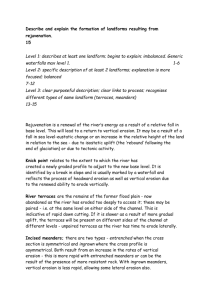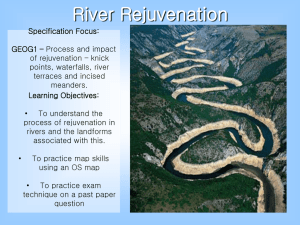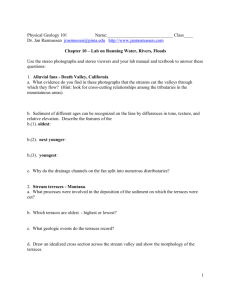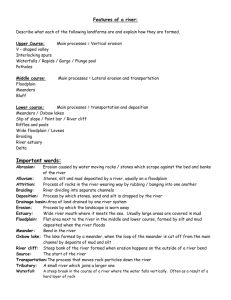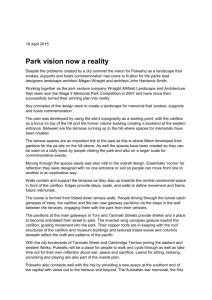River Rejuvenation - geographylwc.org.uk
advertisement
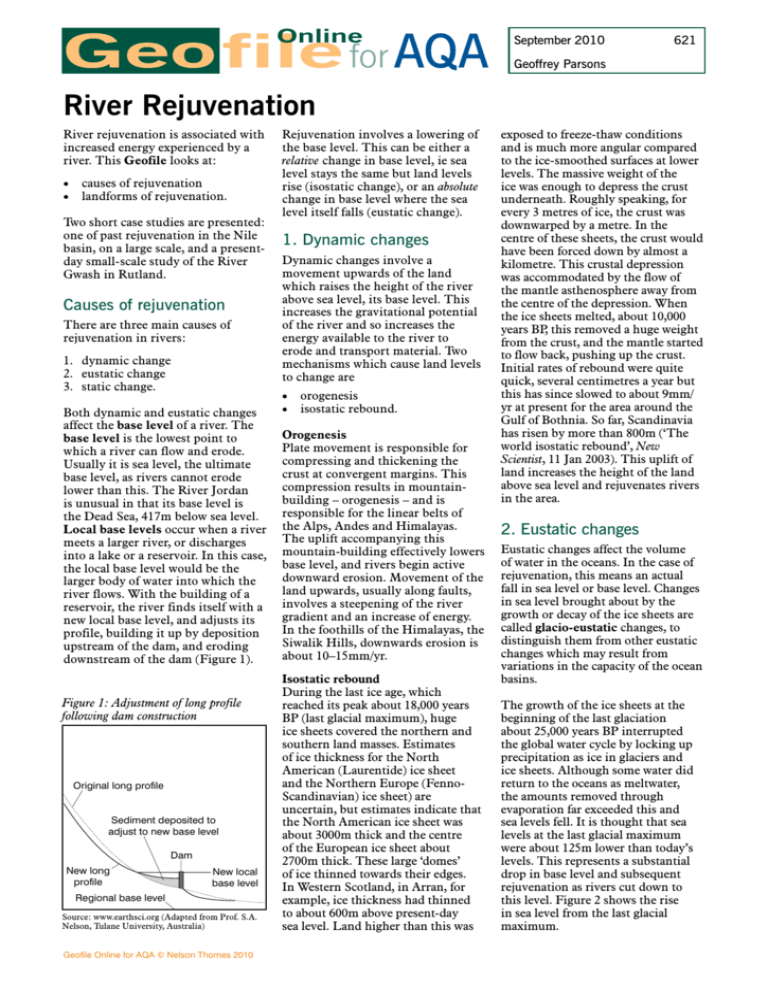
Online September 2010 621 Geoffrey Parsons River Rejuvenation River rejuvenation is associated with increased energy experienced by a river. This Geofile looks at: • causes of rejuvenation • landforms of rejuvenation. Two short case studies are presented: one of past rejuvenation in the Nile basin, on a large scale, and a presentday small-scale study of the River Gwash in Rutland. Causes of rejuvenation There are three main causes of rejuvenation in rivers: 1. dynamic change 2. eustatic change 3. static change. Both dynamic and eustatic changes affect the base level of a river. The base level is the lowest point to which a river can flow and erode. Usually it is sea level, the ultimate base level, as rivers cannot erode lower than this. The River Jordan is unusual in that its base level is the Dead Sea, 417m below sea level. Local base levels occur when a river meets a larger river, or discharges into a lake or a reservoir. In this case, the local base level would be the larger body of water into which the river flows. With the building of a reservoir, the river finds itself with a new local base level, and adjusts its profile, building it up by deposition upstream of the dam, and eroding downstream of the dam (Figure 1). Figure 1: Adjustment of long profile following dam construction Original long profile Sediment deposited to adjust to new base level Dam New long profile New local base level Regional base level Source: www.earthsci.org (Adapted from Prof. S.A. Nelson, Tulane University, Australia) Geofile Online for AQA © Nelson Thornes 2010 GeoFile Series 29 Issue 1 Rejuvenation involves a lowering of the base level. This can be either a relative change in base level, ie sea level stays the same but land levels rise (isostatic change), or an absolute change in base level where the sea level itself falls (eustatic change). 1. Dynamic changes Dynamic changes involve a movement upwards of the land which raises the height of the river above sea level, its base level. This increases the gravitational potential of the river and so increases the energy available to the river to erode and transport material. Two mechanisms which cause land levels to change are • orogenesis • isostatic rebound. Orogenesis Plate movement is responsible for compressing and thickening the crust at convergent margins. This compression results in mountainbuilding – orogenesis – and is responsible for the linear belts of the Alps, Andes and Himalayas. The uplift accompanying this mountain-building effectively lowers base level, and rivers begin active downward erosion. Movement of the land upwards, usually along faults, involves a steepening of the river gradient and an increase of energy. In the foothills of the Himalayas, the Siwalik Hills, downwards erosion is about 10–15mm/yr. Isostatic rebound During the last ice age, which reached its peak about 18,000 years BP (last glacial maximum), huge ice sheets covered the northern and southern land masses. Estimates of ice thickness for the North American (Laurentide) ice sheet and the Northern Europe (FennoScandinavian) ice sheet) are uncertain, but estimates indicate that the North American ice sheet was about 3000m thick and the centre of the European ice sheet about 2700m thick. These large ‘domes’ of ice thinned towards their edges. In Western Scotland, in Arran, for example, ice thickness had thinned to about 600m above present-day sea level. Land higher than this was exposed to freeze-thaw conditions and is much more angular compared to the ice-smoothed surfaces at lower levels. The massive weight of the ice was enough to depress the crust underneath. Roughly speaking, for every 3 metres of ice, the crust was downwarped by a metre. In the centre of these sheets, the crust would have been forced down by almost a kilometre. This crustal depression was accommodated by the flow of the mantle asthenosphere away from the centre of the depression. When the ice sheets melted, about 10,000 years BP, this removed a huge weight from the crust, and the mantle started to flow back, pushing up the crust. Initial rates of rebound were quite quick, several centimetres a year but this has since slowed to about 9mm/ yr at present for the area around the Gulf of Bothnia. So far, Scandinavia has risen by more than 800m (‘The world isostatic rebound’, New Scientist, 11 Jan 2003). This uplift of land increases the height of the land above sea level and rejuvenates rivers in the area. 2. Eustatic changes Eustatic changes affect the volume of water in the oceans. In the case of rejuvenation, this means an actual fall in sea level or base level. Changes in sea level brought about by the growth or decay of the ice sheets are called glacio-eustatic changes, to distinguish them from other eustatic changes which may result from variations in the capacity of the ocean basins. The growth of the ice sheets at the beginning of the last glaciation about 25,000 years BP interrupted the global water cycle by locking up precipitation as ice in glaciers and ice sheets. Although some water did return to the oceans as meltwater, the amounts removed through evaporation far exceeded this and sea levels fell. It is thought that sea levels at the last glacial maximum were about 125m lower than today’s levels. This represents a substantial drop in base level and subsequent rejuvenation as rivers cut down to this level. Figure 2 shows the rise in sea level from the last glacial maximum. September 2010 no.621 River Rejuvenation Figure 2: Post-glacial sea level rise 0 elevated levels of their floodplains also gave the rivers added energy to cut down through the fluvio-glacial sediments to try and establish a graded profile. In doing so they created a number of features typical of rejuvenated landscapes. Present rate of increase Sea level change (m) –20 –40 –60 Meltwater pulse 1A –80 –100 Last glacial maximum –120 –140 24 22 20 18 16 14 12 10 8 6 Thousands of years ago 4 2 0 Source: Wikipedia/www.theoildrum.com below sea level. The Mediterranean Case study: the Nile refilled about 5.3 million years ago – rejuvenation duringGeoFile the Series and29 theIssue rivers1readjusted by filling Fig 621_02 Mac/eps/illustrator 11 sands s/s and gravels. these gorges with Messinian Salinity Crisis NELSON THORNES PUBLISHING Between 5.8 and 5.5 million years Artist: David Russell Illustration 3. Static changes ago, the Mediterranean was isolated These do not involve changes in base from the rest of the world’s ocean level, but are the result of the river’s water by a combination of lowered ability to erode more, due to: sea levels and tectonic movements. Although sea levels fell by about 60m, • changes in the load transported by this would have been insufficient to the river close the links with the Atlantic. It • increase in discharge due to is thought that tectonic uplift raised increase rainfall the land, forming a dam between the • increase discharge through river Atlantic and the Mediterranean. This capture. isolation allowed the Mediterranean to gradually dry up, leaving behind Changes in load salt layers up to 2 km thick in During glacial times, braided places: evaporite deposits formed as meltwater streams carried large a precipitate from the evaporation volumes of material and redeposited of sea water. This period is called them in wide, open valleys. The the Messinian Salinity Crisis. A high discharges of the meltwater and deepwater sea (the Mediterranean unconsolidated nature of the glacial is on average 1.5 km deep and over deposits made eroding this material 5 km at its deepest) could only have easy and so large volumes of debris evaporated if the basin was isolated, were carried and eventually deposited as, in ordinary circumstances, deep over river valleys, building up their oceans never lose enough of their height. Since deglaciation, the load of water to form evaporites. these rivers dropped and this meant that rivers could now employ their The evaporation of the sea water energy, which had previously been meant that in the Mediterranean, sea used in carrying material, to erode. level fell, and rivers running into this Although their discharge, and also deep basin had to adjust to the new their ability to erode had dropped, base level (the new ‘lowstand’) by it was the lack of load that enabled cutting deep canyons. These canyons them to erode their valleys, albeit and gorges are found ‘linked to the slowly. The drop in load was also mouths of modern rivers around brought about by the warming postthe Mediterranean’ (‘The Messinian glacial climate which meant that Salinity Crisis’, from the November vegetation was able to establish itself. 2005 issue of €U(RO)CK (OUGS This contributed to reducing the load Mainland Europe)). The Nile itself by stablising the former bare surfaces had cut down a gorge some 2500m and slowing down the delivery of deep at Cairo. At Aswan, when debris from the sides of the valley building the dam, it was found that where periglacial mass movement the old river channel had cut a gorge had previously contributed large in the granite several hundred metres volumes of debris to the river. The Geofile Online for AQA © Nelson Thornes 2010 Increase in discharge Discharge may vary due to climate change. Additional flow brings more energy with which the river can erode and transport material (increased precipitation) or by one river capturing another. This may mean a progressive lowering of the long profile as vertical erosion is dominant in the upper course of the river. The changes will become less obvious downstream as the difference in height between the old and the new, readjusted profile, become less evident. Landforms of rejuvenation Rivers erode, transport and deposit material throughout their course. Over time, they lower the gradient and smoothe out irregularities. By lowering the profile over time, the river will reduce its energy, and the energy it has will only be enough to transport material. There won’t be enough energy to erode, whilst at the same time there will be too much speed to allow the river to deposit debris. When the river reaches this state of balance, it is said to be graded and the gradient of the river remains stable. Although the gradient may be stable, material is still being transported downstream and replaced when it is removed. In long section, the river has a concave profile which has a gradual decrease in gradient. Any rapid change in the gradient of a river, whether graded or otherwise, brings about changes which affect the whole of the river’s course. In response to this change, the river will adjust its profile to try and bring it into line with the new base level, creating a new concave long profile. As a result of this, a number of features in river valleys are created by the reactivation or rejuvenation of the river as its processes become dominated by erosion once again. There are three types of landform: • terraces (paired, unpaired and types of terraces) • knick points (waterfalls, rapids) • incised meanders (entrenched, ingrown). September 2010 no.621 River Rejuvenation example. The Horseshoe Falls on the Niagara in Canada have retreated by 11km in 10,000 years (over a metre a year), producing a long gorge as it does so. Gulfoss in Iceland has also cut a gorge during its retreat. Figure 3: Paired river terraces Second pair of terraces A First pair of terraces A B C Present day river Today’s flood plain Key A Original flood plain B Second flood plain C Current flood plain terraces at the same level on either side of the river valley. There may Terraces are the level ‘steps’ that have been discrete episodes of 29 Issue 1 are seen on the sides of riverGeoFile Seriesdowncutting to produce the pairs of 621_03 11 s/s valleys which mark theFig level of Mac/eps/illustrator the terraces, which may have come NELSON THORNES PUBLISHING the old floodplain. Terraces can about through episodic falls in base Artist: David Russell Illustration be continuous; they are seen as level. The Thames has two paired long benches stretching along the terraces, the Boyn Hill, being the valley. The surface may ‘dip’ or slope higher and older, and the Taplow downstream at the same angle as the terrace lower down which are found present-day floodplain, but if uplift on both sides of the river. The Boyn has been uneven, then it may differ. Hill terrace is found at Clapham Younger terraces, nearer the presentCommon on the south side and day floodplain, are more likely to be King’s Cross on the north side of the continuous, whereas older terraces Thames. will have suffered more erosion and have sections missing. Unpaired terraces Unpaired terraces form when lateral migration is dominant Terraces can be formed through compared to incision. This is either dynamic or climatic causes. particularly clear in wide valleys In either case, the river will cut where meander migration has taken down, eroding the old floodplain and place. Meandering rivers may cut leaving it above the new floodplain, down quite slowly, in which case, and beyond the effects of flooding. the meander migrates across the In the case of tectonic causes, the floodplain, eroding one side and then extra energy enables the river to the other. By the time the meander incise the old floodplain. In climatic has migrated back to the original cases, it is the reduction of load and side of the valley, sufficient uplift has the discharge: sediment ratio that occurred and will enable the river to increases which gives the river extra cut down to a new, lower level and in energy to cut down. Terraces are so doing create another terrace, a step described as paired or unpaired. below the first one, but not on a level with the second terrace. This happens Paired terraces when downcutting is uninterrupted Paired terraces are levels on either and there is a slow fall in base level. side of the floodplain which are the same height. There may be several 2. Knick points pairs of terraces on the floodplain, Eustatic changes usually affect the like a flight of steps with their river’s long profile from the mouth corresponding terrace on the other and rejuvenation focuses on the lower side (Figure 3). With the decline course. As the river cuts down and in discharge common to many readjusts its profile to its new base rivers after deglaciation, rivers level, it will come to a point upstream changed their form from braiding to where the new ‘readjusted’ profile meandering. Meandering involves meets the older profile. This forms lateral reworking (erosion on the a sharp increase in gradient called a outside of the bend and deposition knick point, which can show itself on the inside) of sediments on as a waterfall or rapids. These will the floodplains. If downcutting of move back upstream by headward the river was quicker than lateral erosion as the river adjusts to a new migration, it would have been quick energy balance. The Beezley Falls on enough to erode both sides of the the River Greta in Yorkshire are an floodplain equally, producing two 1. Terraces Geofile Online for AQA © Nelson Thornes 2010 3. Incised meanders If meanders are already established on the floodplain, then downcutting will result in incised meanders, which can cut down several metres below the old floodplain. There are two types of incised meander: • entrenched meanders • ingrown meanders. Entrenched meanders Entrenched meanders are those which cut down vigorously. Uplift is more rapid than downcutting, and as a result the river produces a symmetrical valley cross-section and the river is found at the bottom of a winding gorge. In this instance there is no meander migration, so the valley sides are symmetrical. The entrenched meanders of the San Juan River, a tributary of the Colorado, show this well. The valley sides are kept steep by a combination of downcutting, the hard rock and lack of weathering and mass movement in this dry region. Ingrown meanders Ingrown meanders have both components of downcutting and lateral erosion. They form when uplift or incision is gradual and this gives the meander time to shift sideways and so produce an asymmetric cross-section. This has a gentle slip-off slope and a steep river cliff, an enlarged form of the meander. Examples are on the River Wye at Tintern, South Wales. Case study: River Gwash, Rutland The River Gwash runs through the village of Braunston in Rutland and thence into Rutland Water. It is a small stream flowing in a valley which shows clear evidence of rejuvenation. During the last glacial maximum, ice covered most of Britain and Ireland, but extended further south in the west of the country, with most of Wales under ice, while most of the Midlands was ice-free. During this time there was probably considerable aggradation of many river valleys that carried September 2010 no.621 River Rejuvenation Figure 4: The River Gwash looking east; Braunston village and its church are visible in the distance meltwater from the ice sheets, due to a combination of: • variable but high discharge • high debris loads • lack of vegetation. The area immediately south of the ice was probably tundra and may have resembled Siberia today, with a relatively restricted vegetation cover. The rivers that flowed over this tundra were probably braided and similar to those we see today in Alaska and would have carried large quantities of sediment, some of which is seen in a layer exposed in the river cliffs. With the drop in discharge the river has changed to a meandering channel and it has cut down into the deposits, removing much of the sediment, leaving the old floodplains as terraces. In this instance, only the most recent paired terrace has survived whilst the older terraces have been eroded away. The river’s downcutting has been quite slow, as marked by the ingrown meander. Since then, there may have been episodes of erosion and deposition to produce today’s landscape. The Geofile Online for AQA © Nelson Thornes 2010 building of Rutland Water has produced a new, localised, base level which will limit the depth of incision by the streams which feed into it, in a manner similar to Figure 1. Figure 4 shows a paired terrace on the River Gwash, marked by the tree on the left and the remains of a cross-country jump on the right, and ingrown meanders, one of which has cut into the paired terrace producing an enlarged river cliff. The students are standing on the remains of an older terrace which rises about 3–4m above the paired terrace. A part of this older terrace is seen sloping down gently from the right. River flow is away from the camera, to the east. The left paired terrace shows evidence of erosion by tributary channels which have cut down to the same depth as the present day channel. F o c u s Q u e s t i o n s 1. Using Figure 4, make a simple line sketch of the area. Label the following: river cliff, slip-off slope, ingrown meander, floodplain, river flow direction (indicate with arrow), paired terrace (left and right), earlier terrace. 2. Draw a simple diagram of the water cycle without the influence of ice. Draw a second diagram to explain how the development of ice sheets leads to eustatic falls in sea level by interrupting the flow of water in the water cycle. 3. Explain why a landscape, which appears to have few indications of rejuvenation, may, in fact, have a complex history of rejuvenation. 4. Make a table with two columns, one headed fast downcutting, the other slow downcutting. Put the following four landforms in the correct column of the table: paired terraces, unpaired terraces, entrenched meanders, ingrown meanders. Explain your choices.
